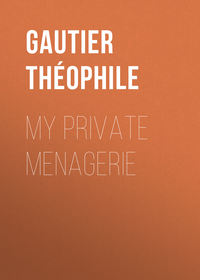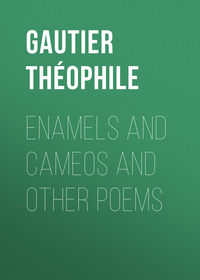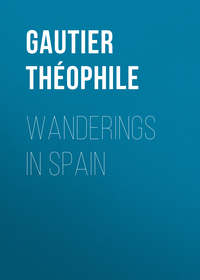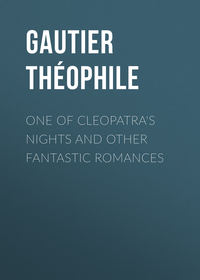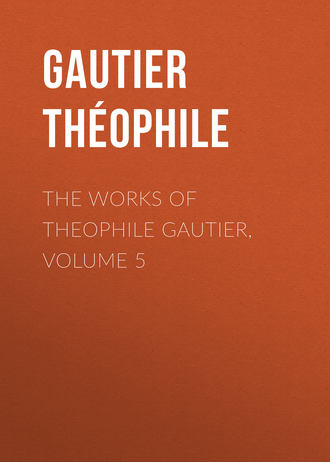 полная версия
полная версияThe Works of Theophile Gautier, Volume 5
And yet all did not sleep. From the walls of a great palace whose entablature, adorned with palmettoes, made a long, straight line against the flaming sky, there came a faint murmur of music. These bursts of harmony spread now and then through the diaphanous shimmer of the atmosphere, and the eye might almost have followed their sonorous undulations. Deadened by the thickness of the walls, the music was strangely sweet. It was a song voluptuously sad, wearily languorous, expressing bodily fatigue and the discouragement of passion. It was full of the eternal weariness of the luminous azure, of the indescribable helplessness of hot countries. As the slave passed by the wall, forgetting the master's lash he would suspend his walk and stop to breathe in that song, impregnated with all the secret homesickness of the soul, which made him think of his far distant country, of his lost love, and of the insurmountable obstacles of fate. Whence came that song, that sigh softly breathed in the silence of the city? What restless soul was awake when all around was asleep?
The straight lines and the monumental appearance of the façade of the palace, which looked upon the face of the square, were typical of the civil and religious architecture of Egypt. The dwelling could belong to a princely or a priestly family only. So much was readily seen from the materials of which it was built, the careful construction, and the richness of the ornamentation.
In the centre of the façade rose a great building flanked by two wings surmounted by a roof in the form of a truncated triangle. A broad, deeply cut moulding of striking profile ended the wall, in which was visible no opening other than a door placed, not symmetrically in the centre, but in the corner of the building, no doubt to allow ample space for the staircase within. A cornice in the same style as the entablature surmounted this single door. The building projected from a wall on which rested like balconies two stories of galleries, resembling open porticoes, composed of pillars singularly fantastic in style. The bases of these pillars represented huge lotus-buds, from the capsule of which, as it opened its dentelated rim, sprang the shaft like a giant pistil, swelling below, more slender at the top, girdled under the capital by a collar of mouldings, and ending in a half-blown flower. Between the broad bays were small windows with their sashes in two parts filled with stained glass. Above ran a terraced roof flagged with huge slabs of stone.
On the outer galleries great clay vases, rubbed inside with bitter almonds and closed with leaves, resting upon wooden pedestals, cooled the Nile water in the draughts of air. Tables bore pyramids of fruits, sheaves of flowers and drinking-cups of different shapes; for the Egyptians love to eat in the open air, and take their meals, so to speak, upon the public street. On either side of the main building stretched others rising to the height of one story only, formed of a row of pillars engaged half-way up in a wall divided into panels in such a manner as to form around the house a shelter closed to the sun and the gaze of the outer world. All these buildings, enlivened by ornamental paintings, – for the capitals, the shafts, the cornices, and the panels were coloured, – produced a delightful and superb effect.
The door opened into a vast court surrounded by a quadrilateral portico supported by pillars, the capitals of which showed on each face a woman's head, with the ears of a cow, long, narrow eyes, slightly flattened noses, and a broad smile; each wore a thick red cushion and supported a cap of hard sandstone. Under the portico opened the doors of the apartments, into which the light came softened by the shade of the galleries. In the centre of the court sparkled in the sunshine a pool of water, edged with a margin of Syêné granite. On the surface of the pond spread the heart-shaped leaves of the lotus, the rose and blue flowers of which were half closed as if overcome by the heat in spite of the water in which they were plunged. In the flower-beds around the pool were planted flowers arranged fanlike upon small hillocks, and along the narrow walks laid out between the beds walked carefully two tame storks, which from time to time snapped their bills and fluttered their wings as if about to take flight. At the angles of the court the twisted trunks of four huge persæas exhibited a mass of metallic green foliage. At the end a sort of pylon broke the portico, and its large bay, framing in the blue air, showed at the end of a long avenue a summer kiosk of rich and elegant design. In the compartments traced on the right and on the left of the arbour by dwarf trees cut into the shape of cones, bloomed pomegranates, sycamores, tamarinds, periplocas, mimosas, and acacias, the flowers of which shone like coloured lights on the deep green of the foliage which overhung the walls.
The faint, sweet music of which we have spoken proceeded from one of the rooms which opened into the interior portico. Although the sun shone full into the court, the ground of which blazed in the flood of light, a blue, cool shadow, transparently intense, filled the apartment, in which the eye, blinded by the dazzling reverberation, sought to distinguish shapes and at last made them out when it had become accustomed to the semi-light. A tender lilac tone overspread the walls of the room, around which ran a cornice painted in brilliant tones and enriched with small golden palm-branches. Architectural designs skilfully combined formed on the plain spaces panels which framed in ornaments, sheaves of flowers, birds, diapers of contrasted colours, and scenes of domestic life.
At the back, near the wall, stood a strangely shaped bed, representing an ox wearing ostrich-feathers with a disc between its horns, broadening its back to receive the sleeper upon a thin red mattress, and stiffening by way of feet its black legs ending in green hoofs, while its curled-up tail was divided into two tufts. This quadruped bed, this piece of animal furniture, would have seemed strange in any other country than Egypt, where lions and jackals are also turned into beds by the fancy of the workmen.
In front of the couch was placed a stool with four steps, which gave access to it: at the head, a pillow of Oriental alabaster, destined to support the neck without deranging the head-dress, was hollowed out in the shape of a half moon. In the centre a table of precious wood carved with exceeding care, stood upon a richly carved pedestal. A number of objects were placed upon it: a pot of lotus flowers, a mirror of polished bronze on an ivory stand, a vase of moss agate filled with antimony powder, a perfume spatula of sycamore wood in the shape of a woman bare to the waist stretching out as if she were swimming, and appearing to attempt to hold her box above the water.
Near the table, on an armchair of gilded wood picked out with red, with blue feet, and with lions for arms, covered with a thick cushion of purple stuff starred with gold and crossed with black, the end of which fell over the back, was seated a young woman, or rather, a young girl of marvellous beauty, in a graceful attitude of nonchalance and melancholy.
Her features, of ideal delicacy, were of the purest Egyptian type, and sculptors must have often thought of her as they carved the images of Isis and Hathor, even at the risk of breaking the rigorous hieratic laws. Golden and rosy reflections coloured her warm pallor, in which showed her long black eyes, made to appear larger by lines of antimony, and full of a languorous, inexpressible sadness. Those great dark eyes, with the eyebrows strongly marked and the eyelids coloured, gave a strange expression to the dainty, almost childish face. The half-parted lips, somewhat thick, of the colour of a pomegranate flower, showed a gleam of polished white and preserved the involuntary and almost painful smile which imparts so sympathetic a charm to the Egyptian face. The nose, slightly depressed at the root, where the eyebrows melted one into another in a velvety shadow, rose in such pure lines, such delicate outlines, and with such well-cut nostrils that any woman or goddess would have been satisfied with it in spite of its slightly African profile. The chin was rounded with marvellous elegance and shone like polished ivory. The cheeks, rather rounder than those of the beauties of other nations, added to the face an expression of extreme sweetness and gracefulness.
This lovely girl wore for head-dress a sort of helmet formed of a Guinea fowl, the half-closed wings of which fell upon her temples, and the pretty, small head of which came down to the centre of her brow, while the tail, marked with white spots, spread out on the back of her neck. A clever combination of enamel imitated to perfection the plumage of the bird. Ostrich-feathers, planted in the helmet like an aigrette, completed this head-dress, which was reserved for young virgins, as the vulture, the symbol of maternity, is worn only by women. The hair of the young girl, of a brilliant black, plaited into tresses, hung in masses on either side of her smooth, round cheeks, and fell down to her shoulders. In the shadowy masses of the hair shone, like suns in a cloud, great discs of gold worn as earrings. From the head-dress hung gracefully down the back two long bands of stuff with fringed ends. A broad pectoral ornament, composed of several rows of enamels, gold and cornelian beads, and fishes and lizards of stamped gold, covered her breast from the lower part of the neck to the upper part of the bosom, which showed pink and white through the thin warp of the calasiris. The dress, of a large checkered pattern, was fastened under the bosom with a girdle with long ends, and ended in a broader border of transverse stripes edged with a fringe. Triple bracelets of lapis-lazuli beads, divided here and there by golden balls, encircled her slender wrists, delicate as those of a child; and her lovely, narrow feet with long, supple toes, were shod with sandals of white kid stamped with designs in gold, and rested on a cedar stool incrusted with red and green enamel.
Near Tahoser (for this was the name of the young Egyptian) knelt, one leg drawn back under the thigh and the other forming an obtuse angle, in the attitude which the painters love to reproduce on the walls of hypogea, a female harpist placed upon a sort of low pedestal, destined no doubt to increase the resonance of the instrument. A piece of stuff striped with coloured bands, the ends of which, thrown back, hung in fluted lappets, bound her hair and framed in her face, smiling mysteriously like that of a sphinx. A narrow dress, or rather sheath, of transparent gauze outlined closely the youthful contours of her elegant, slender form. Her dress, cut below the breast, left her shoulders, chest, and arms free in their chaste nudity. A support, fixed to the pedestal on which was placed the player, and traversed by a bolt in the shape of a key, formed a rest for the harp, the weight of which, but for that, would have borne wholly upon the shoulders of the young woman. The harp, which ended in a sort of keyboard, rounded like a shell and covered with ornamental paintings, bore at its upper end a sculptured head of Hathor surmounted by an ostrich-plume. The nine cords were stretched diagonally and quivered under the long, slender hands of the harpist, who often, in order to reach the lower notes, bent with a sinuous motion as if she were about to float on the waves of music and accompany the vanishing harmony.
Behind her stood another musician, who might have been thought nude but for the faint white haze which toned the bronze colour of her body. She played on a sort of guitar with an exceedingly long handle, the three cords of which were coquettishly adorned at their extremity with coloured tufts. One of her arms, slender yet round, grasped the top of the handle with a sculptural pose, while the other upheld the instrument and touched the strings.
A third young woman, whose enormous mass of hair made her look all the more slender, beat time upon a tympanum formed of a wooden frame slightly curved inward, on which was stretched an onager-skin.
The harpist sang a plaintive melody, accompanied in unison, inexpressibly sad. The words breathed vague aspirations, vague regrets, a hymn of love to the unknown, and timid plaints of the rigour of the gods and the cruelty of fate. Tahoser, leaning upon one of the lions of her armchair, her hand under her cheek and her finger curved against her temple, listened with inattention more apparent than real, to the song of the musician. At times a sigh made her breast heave and raised the enamels of her necklace. Sometimes a moist light caused by a growing tear shone in her eye between the lines of antimony, and her tiny teeth bit her lower lip as if she were fighting her own emotion.
"Satou," she said, clapping her delicate hands together to silence the musician, who at once deadened with her palm the vibrations of the harp, "your song enervates me, makes me languid, and would make me giddy like overpowerful perfumes. The strings of your harp seem to be twisted with the vibrations of my heart and sound painfully within my breast. You make me almost ashamed, for it is my soul that mourns in your music. Who can have told you my secrets?"
"Mistress," replied the harpist, "the poet and the musician know everything; the gods reveal hidden things to them; they express in their rhythm what the thought scarcely conceives and what the tongue confusedly stammers. But if my song saddens you, I can, by changing its mode, bring brighter ideas to your mind." And Satou struck the cords of her harp with joyous energy, and with a quick measure which the tympanum marked with more rapid strokes.
After this prelude she began a song praising the charms of wine, the intoxication of perfumes, and the delight of the dance. Some of the women, who, seated upon folding-stools formed of the necks of blue swans, whose yellow bills clasped the frame of the seat, or kneeling upon scarlet cushions filled with the down of thistles, had assumed under the influence of Satou's music poses of utter languor, shivered; their nostrils swelled; they breathed in the magic rhythm; they rose to their feet, and, moved by an irresistible impulse, began to dance. A head-dress, in the shape of a helmet cut out around the ear, enclosed their hair, some locks of which escaped and fell upon their brown cheeks, which the ardour of the dance soon turned rosy. Broad golden circles beat upon their necks, and through their long gauze shifts, embroidered at the top with pearls, showed their golden bronze bodies which moved with the ease of an adder. They twisted, turned, swayed their hips, bound with a narrow black girdle, threw themselves back, bowed down, inclined their heads to right and left as if they found a secret voluptuousness in touching their polished chins with their cold, bare shoulders, swelled out their breasts like doves, knelt and rose, pressed their hands to their bosom or voluptuously outspread their arms, which seemed to flutter as the wings of Iris or Nephthys, dragged their limbs, bent the knee, displayed their swift feet with little staccato movements, and followed every undulation of the music. The maids, standing against the wall to leave free space for the evolutions of the dancers, marked the rhythm by snapping their fingers or clapping their hands together. Some of these maids, absolutely nude, had no other raiment than a bracelet of enamelled ware; others wore a narrow cloth held by straps, and a few sprays of flowers twisted in their hair. It was a strange and graceful sight. The buds and the flowers, gently moving, shed their perfume through the hall, and these young women, thus wreathed, might have suggested fortunate comparisons to poets.
But Satou had overestimated the power of her art. The joyous rhythm seemed to increase Tahoser's melancholy. A tear rolled down her fair cheek like a drop of Nile water on a nymphœa, and hiding her face in the breast of her favourite maid, who leaned upon the armchair of her mistress, she uttered with a sob, dovelike in its sadness, "Oh, my dear Nofré, I am very sad and very unhappy!"
II
Nofré, anticipating some confidence, made a sign, and the harpist, the two musicians, the dancers, and the maids silently withdrew one by one, like the figures painted on frescoes. When the last had gone, the favourite said to her mistress in a petting, sympathetic tone, like a young mother soothing her child's tender grief, —
"What is the matter, dear mistress, that you are sad and unhappy? Are you not young, so fair that the loveliest envy you, and free to do what you please? And did not your father, the high-priest Petamounoph, whose mummy rests concealed within a rich tomb, – did he not leave you great wealth to do with as you please? Your palace is splendid, your gardens vast and watered by transparent streams, your coffers of enamelled ware and sycamore wood are filled with necklaces, pectorals, neck-plates, anklets, finely wrought seal-rings. Your gowns, your calasiris, your head-dresses are greater in number than the days of the year. Hopi, the father of waters, regularly covers with his fertilising mud your domains, which a vulture flying at top speed could scarce traverse from sunrise to sunrise. And yet your heart, instead of opening joyously like a lotus bud in the month of Hathor or of Choeak, closes and contracts painfully."
Tahoser answered Nofré: —
"Yes, indeed, the gods of the higher zones have treated me favourably. But what matter one's possessions if one lacks the one thing desired? An unsatisfied wish makes the rich as poor, in his gilded, brightly painted palace, in the midst of his heaps of grain, of perfumes and precious things, as the most wretched workman of the Memnonia, who sops up with sawdust the blood of the bodies, or the semi-nude negro driving on the Nile his frail papyrus-boat under the burning midday sun."
Nofré smiled, and said with a look of imperceptible raillery, —
"Is it possible, O mistress, that a single one of your fancies has not been fulfilled at once? If you want a jewel, you give the workman an ingot of pure gold, cornelians, lapis-lazuli, agates, and hematite, and he carries out the wished-for design. It is the same way with gowns, cars, perfumes, flowers, and musical instruments. From Philæ to Heliopolis your slaves seek out for you what is most beautiful and most rare; and if Egypt does not hold what you want, caravans bring it to you from the ends of the world."
The lovely Tahoser shook her pretty head and seemed annoyed at her confidante's lack of intelligence.
"Forgive me, mistress," said Nofré, changing her tone as she understood that she had made a mistake. "I had forgotten that it will soon be four months since the Pharaoh left on his expedition to Upper Ethiopia, and that the handsome oëris (general), who never passed under the terrace without looking up and slowing his steps, accompanies His Majesty. How well he looked in his uniform, how handsome, young, and bold!"
Tahoser's rosy lips half parted, as if she were about to speak, but a faint, rosy flush spread over her cheeks, she bowed her head, and the words ready to issue forth did not unfold their sonorous wings.
The maid thought she had guessed right, and continued, —
"In that case, mistress, your grief will soon end, for this morning a breathless runner arrived, announcing the triumphal return of the king before sundown. Have you not already heard innumerable rumours buzzing confusedly over the city, which is awakening from its midday torpor? List! The wheels of the cars sound upon the stone slabs of the streets, and already the people are hurrying in compact bodies to the river bank, to cross it and reach the parade ground. Throw off your languor and come also to see that wondrous spectacle. When one is sad, one ought to mingle with the crowd, for solitude feeds sombre thoughts. From his chariot Ahmosis will smile graciously upon you, and you will return happier to your palace."
"Ahmosis loves me, but I do not love him," answered Tahoser.
"You speak as a maid," replied Nofré, who was very much smitten with the handsome officer, and who thought that the disdainful nonchalance of Tahoser was assumed. In point of fact, Ahmosis was a very handsome fellow. His profile resembled that of the images of the gods carved by the most skilful sculptors. His proud, regular features equalled in beauty those of a woman; his slightly aquiline nose, his brilliant black eyes lengthened with antimony, his polished cheeks, smooth as Oriental alabaster, his well-shaped lips, his tall, handsome figure, his broad chest, his narrow hips, his strong arms on which, however, no muscle stood out in coarse relief, were all that were needed to seduce the most difficult to please; but Tahoser did not love him, whatever Nofré might think. Another idea, which she refrained from expressing, for she did not believe Nofré capable of understanding her, helped the young girl to make up her mind. She threw off her languor, and rose from her armchair with a vivacity quite unexpected after the broken-down attitude she had preserved during the singing and the dancing.
Nofré, kneeling before her, fastened on her feet sandals with turned-up ends, cast scented powder on her hair, drew from a box several bracelets in the shape of serpents, and a few rings with sacred scarabæi for gems, put on her cheeks a green powder which immediately turned rose-colour as it touched the skin, polished her nails with a cosmetic, and adjusted the somewhat rumpled folds of her calasiris like a zealous maid who means that her mistress shall show to the greatest advantage. Then she called two or three servants, and ordered them to make ready the boat and transport to the other side of the river the chariot and oxen.
The palace, or if this name seems too pompous, the dwelling of Tahoser, rose close to the Nile, from which it was separated by gardens only. Petamounoph's daughter, her hand resting on Nofré's shoulder, and preceded by her servants, walked down to the water-gate through the arbour, the broad leaves of which, softening the rays of the sun, flecked with light shadows her lovely face. She soon reached the wide brick quay, on which swarmed a mighty multitude, awaiting the departure or return of the boats.
The vast city held now only the sick, the invalids, old people unable to move, and the slaves left in charge of the houses. Through the streets, the squares, the dromos (temple avenues), down the sphinx avenues, through the pylons, along the quays, flowed streams of human beings all bound for the Nile. The multitude exhibited the strangest variety. The Egyptians were there in largest numbers, and were recognisable by their clean profile, their tall, slender figures, their fine linen robes or their carefully pleated calasiris. Some, their heads enveloped in striped green or blue cloth, with narrow drawers closely fitting to their loins, showed to the belt their bare torsos the colour of baked clay. Against this mass of natives stood out divers members of exotic races: negroes from the Upper Nile, as black as basalt gods, their arms bound round with broad ivory rings, their ears adorned with barbaric ornaments; bronzed Ethiopians, fierce-eyed, uneasy, and restless in the midst of this civilisation, like wild beasts in the glare of day; Asiatics with their pale-yellow complexion and their blue eyes, their beard curled in spirals, wearing a tiara fastened by a band, and draped in heavily embroidered, fringed robes; Pelasgi, dressed in wild beasts' skins fastened on the shoulder, showing their curiously tattooed legs and arms, wearing feathers in their hair, with two long love-locks hanging down. Through the multitude gravely marched shaven-headed priests with a panther's-skin twisted around their body in such a way that the head of the animal formed a sort of belt-buckle, byblos shoes on their feet, in their hand a tall acacia-stick on which were engraved hieroglyphic characters; soldiers, their silver-studded daggers by their side, their bucklers on their backs, their bronze axes in their hands; distinguished personages, their breasts adorned with neck-plates of honour, to whom the slaves bowed low, bringing their hands close to the ground; and sliding along the walls with humble and sad mien, poor, half-nude women travelling along bowed under the weight of their children suspended from their neck in rags of stuff or baskets of espartero; while handsome girls, accompanied by three or four maids, passed proudly with their long, transparent dresses knotted under their breasts with long, floating scarfs, sparkling with enamels, pearls, and gold, and giving out a fragrance of flowers and aromatic essences.


